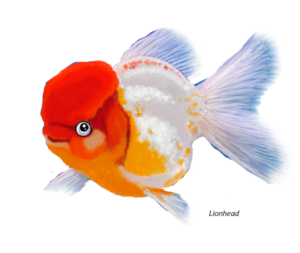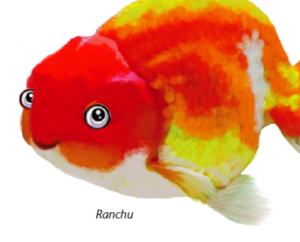The Hobbyist
After six months to a year of enjoying the community tank goldfish, many hobbyists get hooked. They start doing more research on the subject matter in books, magazines, the Internet, and on social media, also attending local goldfish shows. They learn new ways to improve their involvement in the hobby in terms of: Varieties: Hobbyists buy more of the popular goldfish based on country of origin, color varieties, and size. They consider buying varieties that require more care.
They are likely to consider the following (information sourced mostly from Wikipedia):

• The Celestial: A double-tailed goldfish with a pair of telescoping eyes turned upwards, pupils gazing skyward. Celestials have elongated, egg-shaped bodies and do not have dorsal fins. Most commonly, they have metallic scales in shades of orange.

• The Bubble Eye: This dorsal-less fancy goldfish’s eyes, paired with two large fluid-filled sacs, point upwards. This variety is fragile and should be kept separately from boisterously-inclined fish; also, avoid sharp tank décor. If punctured, the “bubbles” will regrow. Popular colors are orange and black.

• The Lionhead: This goldfish is egg-shaped, with a body that is short and stubby; it also does not have a dorsal fin. Its most distinctive feature is its head which, save for the eyes, mouth, and nostrils, can be completely covered with a fleshy growth called a ‘wen’. Though they come in almost all colors, most Lionheads are orange or a mix of orange and white; these days, black is a popular color.

• The Ranchu: Considered the ‘king’ of goldfish by the Japanese, the ranchu’s head is its most distinctive feature; hobbyists consider larger space between the eyes and from the eyes to the front of the head to be ideal.
Compared to the lionhead, which it is similar to, the Ranchuranchu’s tail is more downturned, as is its tail fin. However, its arched back is more pronounced and a more rounded back is considered ideal. Its tail is markedly shorter and makes a sharp angle inwards. It also does not have a dorsal fin. The most prominent feature of the ranchu is its head. There must be sufficient space between the eyes, and also from the eyes to the front of the head. Among its colors are black, blue, chocolate brown, orange, red, and white; color combinations include black and red, black and white, and red and white.
There are two types of ranchus according to how they are appreciated: the TVR or top view ranchus, and SVR or side view ranchus.
Other popular varieties are:
• Jikin
• Lionchu
• Orkin
• Wakin
Feeds: Feeding contributes to growth, health, and coloration. There are three kinds of feed to choose from:
• Live food. These include blood worms, tubifex worms, and Moina or daphnia. These are the most common. Care when it comes to cleaning live food before feeding these to your goldfish is important.
• Branded commercial feeds. From generic flakes and pellets, hobbyists can experiment with different brands available that promise the best for our beloved goldfish. The packaging for most branded feeds carry their nutritional information.
• Own recipe. There are so many ways to provide the freshest ingredients with the highest value that hobbyists who choose this route become like chefs. The most popular ingredients for private concoctions are chicken or beef heart, peas, carrots, multivitamins, and gelatin for binding.
Multiple Tanks: Yes, there is such a thing as ‘multiple tank syndrome’. We add different sizes of tanks for each variety to better address its specific needs. Ranchu and Lionheads, for example, are better off with low height tanks. Quarantine and hospital tanks are also needed.
Water quality: This is the heart of the overall health of goldfish. Wanting to ensure water quality, hobbyists learn how to do water tests using water test kits. Important water parameters to test are ph, ammonia, nitrites, and nitrates.Filtration: From box type, sponge, and under-gravel filters, hobbyists advance to more efficient filters such as the overhead canister, diatoms, fluidized bed, and sumps.
The Advanced Hobbyist
Advanced hobbyists focus on developing their own breeds and discovering more advanced techniques in improving goldfish quality. They are beginning to be curious about the possibility of generating an income from the hobby.
• Breeding: they learn, experiment, pick, and breed their favorite fish, and share some of their fish with fellow hobbyists or friends, or even sells the excess.
• Genetics: they learn how to match to obtain desired colors, body sizes, and tails.
• Advanced research: they attend international shows and make farm visits, taking copious amounts of pictures.
• Competition: they begin to compete in different local goldfish competitions.
The Entrepreneur
Entrepreneurs can now rely on their goldfish for a regular source of income. They can do this several ways:
• Blogger: sharing the basics, advanced theories, and personal experiences.
• Importer: supplying resellers, pet shops, and hobbyists; both fish and accessories are imported from other Asian and European countries.
• Reseller: to hobbyists or pet shops, either by direct or online selling• Backyard breeder: maximizing home facilities for income purposes. Having a home business increases the time such hobbyists have for their families and other personal responsibilities. They often supply neighborhood pet shops.
• Farm breeder: supplying main distributors for local pet shops and exports quality goldfish.With so many varieties of goldfish and opportunities for the hobbyist and/or entrepreneur to grow, the future of goldfish will always be exciting.
This appeared in Animal Scene’s October 2015 issue.






